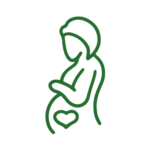WHAT IS IT?
Ovarian cysts are fluid-filled sacs or pockets within or on the surface of an ovary. Many women have ovarian cysts at some time during their lives. Most present little or no discomfort, are harmless and disappear without treatment within a few months.
Ovarian cysts typically develop as a result of the normal function of your menstrual cycle. Your ovaries normally grow cyst-like structures called follicles each month. Follicles produce the hormones estrogen and progesterone and release an egg when you ovulate. Sometimes a normal monthly follicle keeps growing. When that happens, it is known as a functional cyst.
Cysts not related to the normal function of your menstrual cycle — nonfunctional cysts — may contain tissue, such as hair, skin or teeth, because they form from cells that produce human eggs.
Or they may be filled with a watery liquid or a mucous material. These are rare.
SYMPTOM CHECKER
Some ovarian cysts — especially those that have ruptured — can produce symptoms. A large ovarian cyst can cause abdominal discomfort. If a large cyst presses on your bladder, you may feel the need to urinate more frequently because bladder capacity is reduced.
Signs and symptoms of ovarian cysts may include:
- Pelvic or abdominal pain — a dull ache that may radiate to your lower back and thighs
- Pelvic pain shortly before your period begins or just before it ends
- Pelvic pain during intercourse
- Pain during bowel movements or pressure on your bowels
- Nausea, vomiting or breast tenderness similar to that experienced during pregnancy
- Fullness or heaviness in your abdomen
- Pressure on your bladder that causes you to urinate more frequently than normal or to have difficulty emptying your bladder completely
TREATMENT
Your doctor may recommend tests, including an ultrasound exam, to help determine the size and type of cysts. In addition to these factors, treatment will depend on your age and your signs and symptoms. Your doctor may suggest:
Watchful waiting. In many cases, you can wait to see if the cyst goes away on its own within a few months. This is typically an option if you have no symptoms and the cyst is small and filled with fluid. Your doctor will likely recommend follow-up exams to see if the cyst has changed in size.
Birth control pills. Birth control pills can reduce the chance of new cysts developing in future menstrual cycles.
Surgery. If the cyst is large, it doesn’t look like a functional cyst, it’s growing, or it persists through two or three menstrual cycles, your doctor may recommend surgery. Some cysts can be removed without removing the ovary. In some circumstances, your doctor may suggest removing the affected ovary and leaving the other ovary intact. Your doctor may also recommend surgery if a cystic mass develops on the ovaries after menopause.
Excerpt From: The Mayo Clinic. “Mayo Clinic A to Z Health Guide”.






































































